_(920_x_351_px)_835_265_c1.jpg)
One Book, One Town 2025
Westwood Public Library is inviting the community to come together to read the same book and explore its major themes with discussions and interactive programs and an author visit! It's also, to put it simply, a really fun and social way to get the most out of a book. Let's read together!
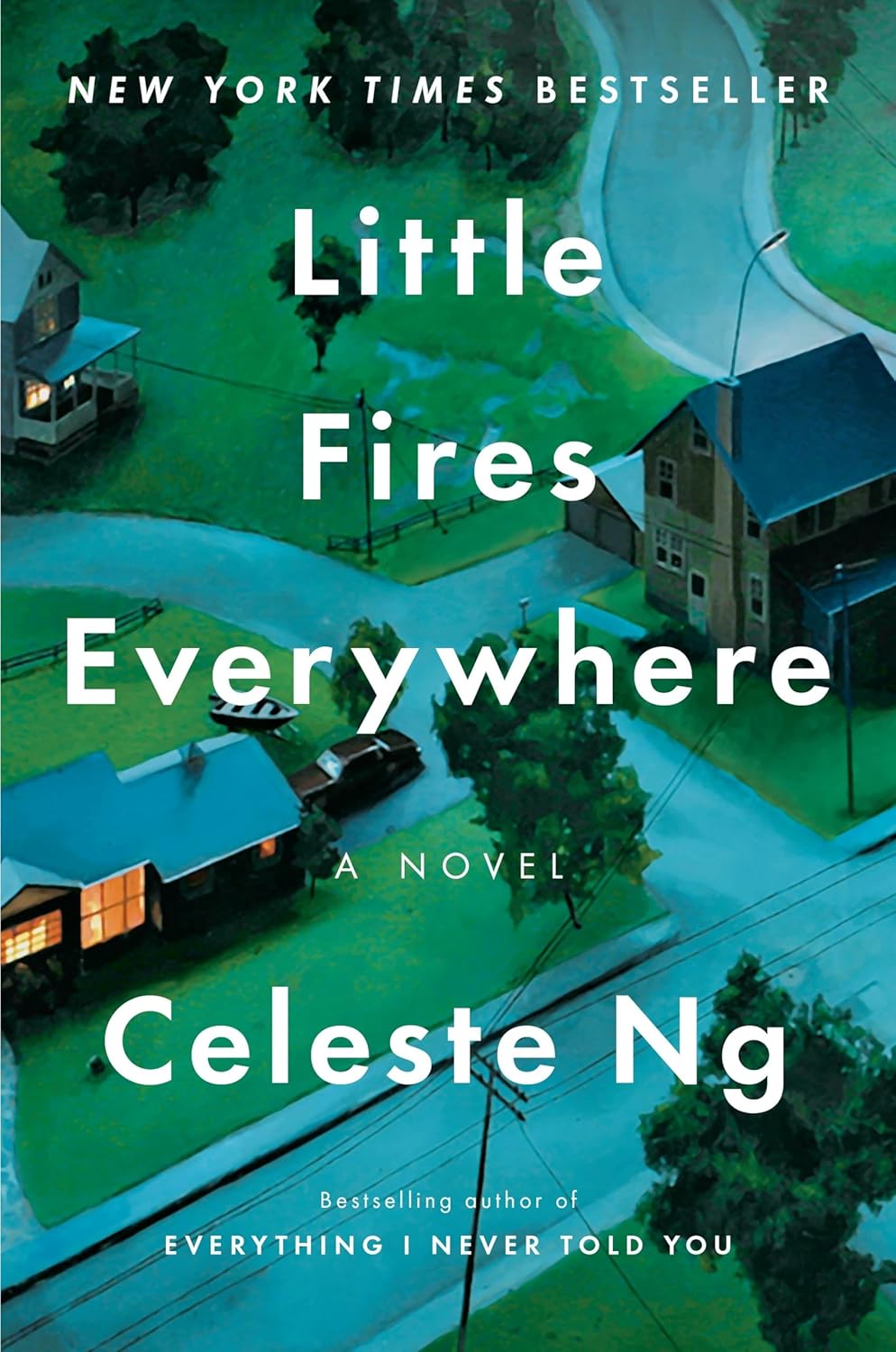
Our first One Book One Town will be Little Fires Everywhere and culminate in an in-person author visit from Celeste Ng! One Book One Town promotes literacy, fosters community and provides common ground for intergenerational, cross-cultural and civic-minded educational discussions. This initiative is funded by the 21st Century Fund and we are so thankful for their generous contribution to special events, collections, technology, and more.
Writing Contest Winner: Caitlin Anne
Prom at the Waldorf Astoria, 1951
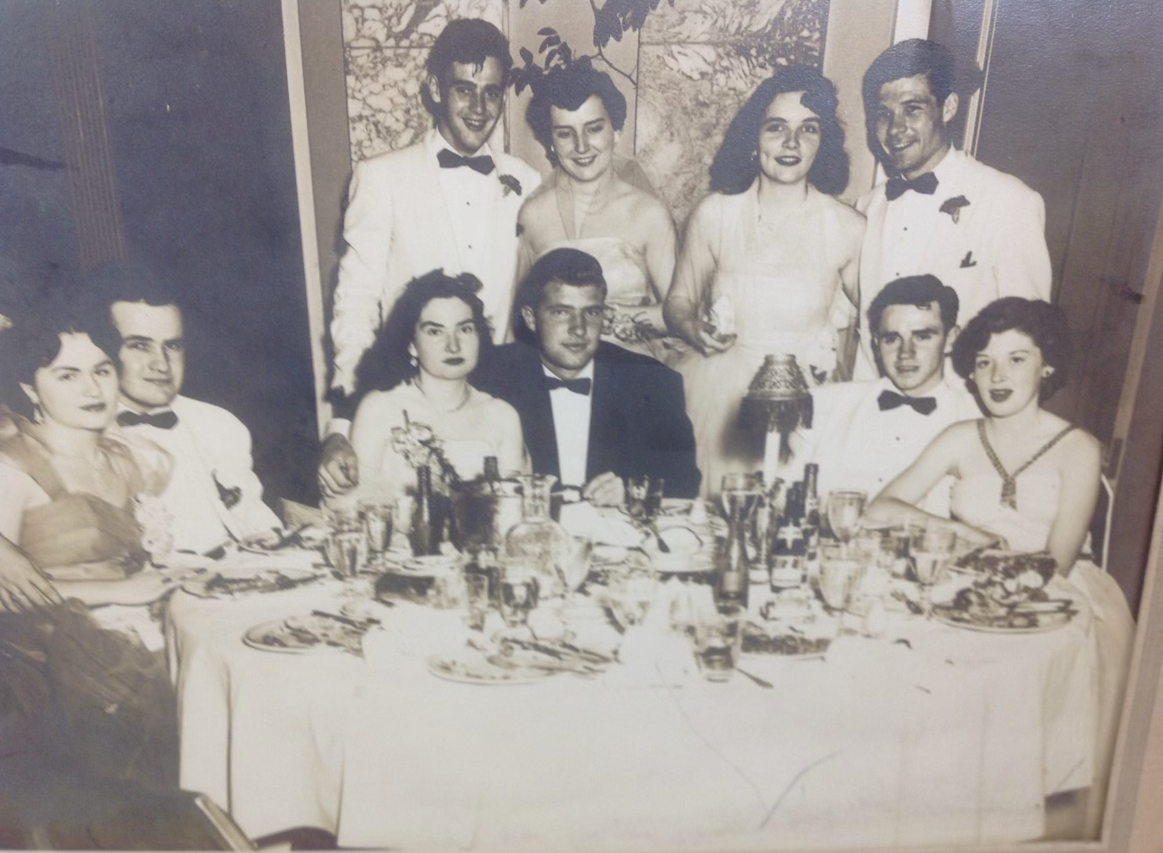
Photo of the author's grandmother at her senior prom in 1951
The sight of the dress in the display window sent the girls into an absolute tizzy. They entered the boutique, a pack of barely-teenagers with an energy bordering on hysteria. Anne motioned to the group that she would be a minute and stood quietly, taking in the gown which was so beautiful it did not seem real. That her dress had been chosen for the window display Anne took as a sign from the Prom Gods themselves, the first physical proof of the insofar mythological Thursday night ahead of the girls.
Anne would forget almost every detail about the prom later in her life: how she got there, the friends she’d arrived with, even her date - but she would until her final days remember standing on this quiet New York street corner in April.
Behind the mannequin, Anne could see the girls inside preparing to try on their own dresses. The venue for prom had been announced last month to their ecstatic disbelief. The Waldorf Astoria; Anne had bit the inside of her cheek when the nuns announced it at lunch. The running theory had been the Irish Center, their unassuming Catholic high school neither wealthy nor, Anne thought, creative enough to splash out further. Speculations on favors— and which nuns had performed them— began before the bell, none of them savory. But Anne felt in her bones that the upcoming event was being orchestrated by a higher power. That her life, which felt inconsequential so far, mostly made up of endless stretches in the hospital, had somehow been preparing her for this moment. Arriving in the ballroom on Thursday, in this stunning gown, at the Waldorf Astoria.
She reached her fingertips to the window, imagining the dress on her own body in just a matter of days. Anne’s entrance into the ballroom on prom night had played over and over in her mind for months like a cartoon sketch,the details filling in as each decision was made. Soft pink would color the dress in her mind that night as she went to sleep, its four gold-encircled pearls gathering fabric at her hip before flowing out into soft pools at the floor.
Anne was mesmerized, memorizing the details for her own sweet dreams that evening. Night or day, it was her entrance that Anne could not stop thinking about. She had placed her chin in her hands during the impossibly long school days and drifted: what song would be playing? Whose faces would stand out in the room of turned heads, nodding approvingly at her majestic but of course benevolent wave? Whose eyes would she meet, look away from, and find over and over again in the room— to wind up staring into while dancing? Her sixteen years had held enough education for the simplistic world she needed to understand following school— marriage, homemaking, and children— but had not prepared her for this interlude before all that predictability. She simply could not contain her excitement within her body.
“Anne? What are you doing out here? Come try on your dress!”
Alice, Anne’s closest friend, interrupted her thoughts. Anne dutifully stepped inside, joining her friends by the fitting rooms. The girls had seamlessly picked up the prom conversation where it had left off in the morning. Alice was preoccupied with her weight; her mother had refused both alterations to Alice’s dress and her daughter’s evening dessert since February. Bernice had recently cut her hair and awoke each morning and went to bed each evening desperately wishing she had not. The tallest girl in the class was Angela, and she was tormented by the lack of decent shoe options without heels.
Anne listened patiently to her friends’ worries, but the details that haunted the other girls were just background noise to Anne. She easily chose her dress and accessories, as it was not details but the romanticism of it all that had swept Anne off her feet, and her veins burned with anticipation. She felt older than her years, than her friends certainly. Diagnosed with tuberculosis as a child, she had already survived worrisome tests, much emotional distress in her family, and worst of all, so many endless, boring months in the hospital. She felt—more than anything—a certain wonderment to be a part of it all.
The girls began trying on their dresses, and the store attendant went to fetch Anne’s from the display. The group’s conversation landed at its inevitable destination: the boys.
Dates for the event had been chosen fairly officially. The local Catholic boys’ school would be attending; an orchestrated dance a few months ago had provided the girls and boys a chance to pair. Anne had accepted her first offer from a sweet-looking Irish boy, at the same time knowing he would not become her husband. She was relieved that she didn’t harbor an attraction to him: she could enjoy the evening distraction-free. The time she’d spent in hospital had given Anne a sense of certainty about what she wanted, an ease in making decisions that came only to those who had survived something serious. She would meet her actual husband John a few short months following prom, and Anne would decide to marry him as easily as she’d picked her dress.
Living on borrowed time as Anne felt she was, everything—including hardship— was a part of the gift of life to her, a mystery she didn’t understand but was determined to embrace. Later in life, and when she was finally separate from the school nuns she would turn to her own version of faith to guide her through difficult times. But the building blocks of Anne’s resilience were established in her quarantined youth, as if her factory settings were reset during those hospital stays; perseverance was all she knew.
In the fitting room, Anne pulled the soft pink dress up her body quickly, as she did not like gazing at the scars she had earned from the hospital bed on her legs. She exhaled as soon as the dress covered most of her and looked appreciatively at her reflection— the dress suited her very much. The murmurs from her friends and the attendants confirmed this when she exited the changing room. She wished she could bottle up the feeling and wear it around like perfume.
After the fitting, Anne returned home to dinner with her family, regaling her mother, father and brother with every detail. Anne was happy, and her family was happy for her, and the bubble of positivity was utter relief after the difficult months prior, when they hadn’t been sure Anne would be able to attend prom. Her father was an undertaker, the morgue below the basement of their home. When the conversation changed, Anne daydreamed once again. She silently remarked on her good fortune, wondering if the person lying on the table downstairs embalmed in formaldehyde would trade something to come back to Earth and dance for one night at the Waldorf, and if so, what?
Tuesday and Wednesday passed blessedly quickly for Anne. She rushed through dinner on Wednesday evening, eager to get into bed and dream about tomorrow. Her dress hung on the back of her closet door. After saying her prayers, Anne lay awake, smiling at her dress until she fell asleep.
The girls gathered at Anne’s house with their dates for pictures, all their issues resolved except for Alice’s dress closure, which had been fastened haphazardly with pins and was threatening to come apart at any moment. Anne’s parents and brother had taken her in appreciatively and sweetly as she came down the stairs. She noticed her mother’s eyes wet in the pale light of dusk, and Anne would remember her that way years later, when she was gone from Anne’s life too soon and her own children were still so young, too young to tell them the story yet. In the moment Anne felt light and happy, wishing that she could have more photos than the few they were able to take. She wanted to remember each part of this evening forever.
The air in Manhattan felt electric, the city coming alive as the small group made their way to the entrance of the hotel. Her friends had already dissipated with their dates— as much as tonight felt like a coming together of her youth, it also felt like her friends were already coming apart, taking strides into their new lives. Inside the grand hallway, the doors to the ballroom swung open, revealing peals of laughter and a tower of champagne glasses higher than Anne’s front door. She caught a glimpse of herself in the mirror, and suddenly her throat constricted, and she felt dizzy and nauseous all at once. Anne excused herself from her date and beelined for the powder room.
Once inside, she found a small sofa in a quiet corner not occupied by groups of overly excited girls. She sat and breathed, as she had taught herself to do in the hospital when fear had gripped her before surgeries. In, hold it, and out. Anne did this for several minutes, but intrusive thoughts of her time in the hospital came in waves. She had been so focused on the prom she had so desperately wanted— it was as if every emotion from her challenging youth hit her right on the cusp of her long-awaited evening. Anne felt an overwhelming panic – or was it a sense of loss – as someone who was about to get exactly what they wished for.
She sat and breathed and sat and breathed. She breathed as she had many times before, and would again in other trying, turbulent moments of her life yet unlived. She had missed out on so much— friends, school, young romance. Walks to the park, ice cream in summer, her parents at dinnertime. She had her brother, her reluctant but steadfast sentry during the hospital stays, whose sense of aliveness enabled her own during those long stretches of time. A lifetime later, into their nineties, they would continue to speak daily on the phone, and he would still make her laugh every time.
As she sat and breathed, she thought of her brother’s face, so proud of her tonight as she came down the stairs in her pink dress. And slowly, Anne’s panic began to fade. She had missed so much and yet, she had so much life left to live. She had tonight, and the rest of her life, right in front of her now.
A sense of relief filled her chest and spread out to her arms and to her feet, free from the hospital bed and more than ready to dance. She clasped her hands to her chest, bowed her head and quietly said “thank you.” Anne washed her hands, and her reflection smiled back at her. She patted her dress, her fingers caressing the pearl buttons gathered at her hip, above scars that were as a part of her as the stars in the universe. She took a final deep breath and opened the door into her night.
About the Author:
Caitlin Anne is a writer-by-night living in Norwood with her husband, son and daughter. She proudly shares this award with her beloved late grandmother Anne, whose photo of her senior prom inspired this piece. Caitlin loves to be a part of the local writing (and reading!) community: find her on Instagram @caitlinannewriter

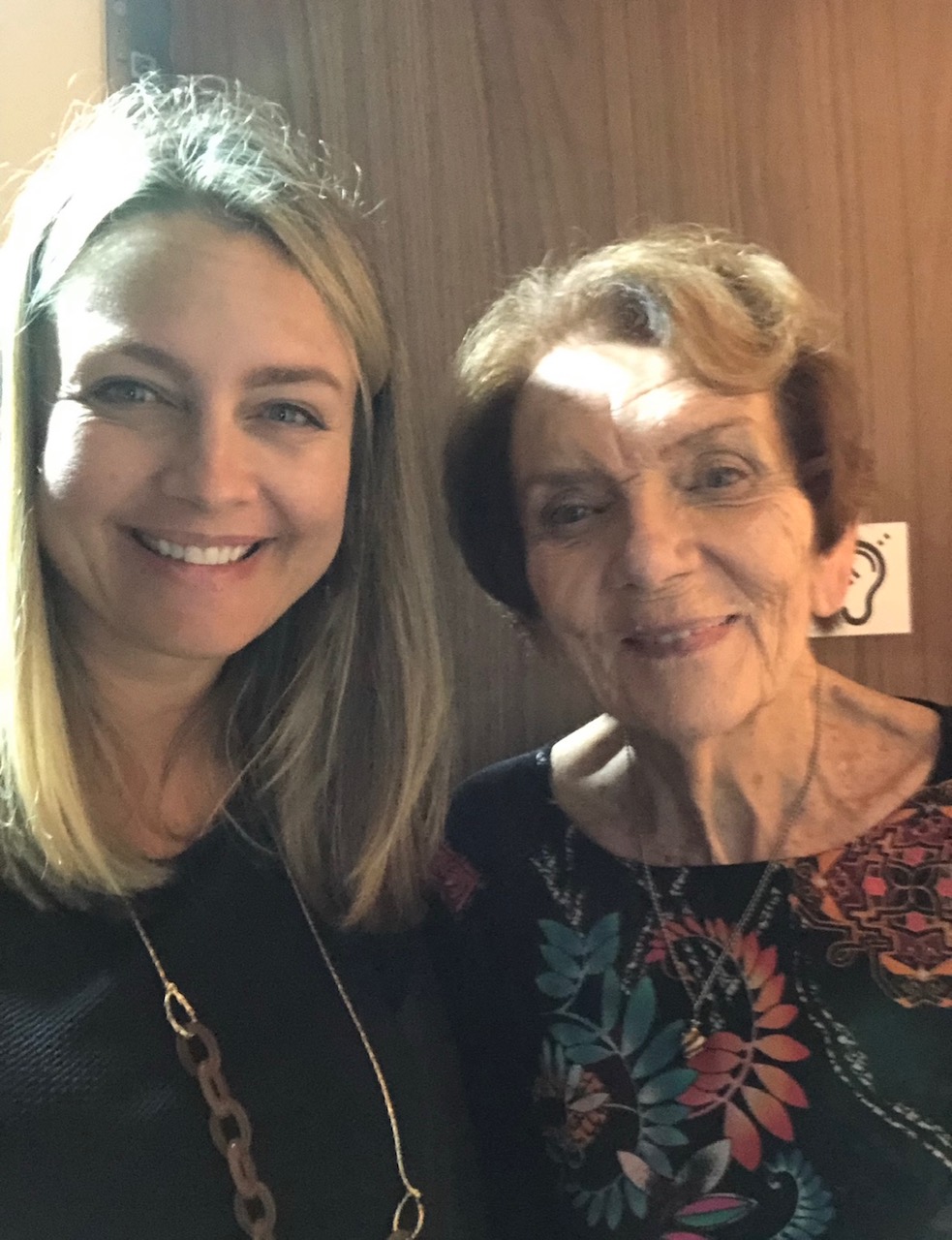
A central theme of Celeste Ng’s 2017 novel, Little Fires Everywhere, is taking artistic action and speaking out about things that matter to you. As a part of One Book One Town 2025, we are inviting writers in our community to share their voices and submit writing that responds to one or more themes from the book, Little Fires Everywhere. Writing can either be a direct response to the novel, or an interpretation of one of the novel’s core themes:
Themes:
Order and disruption
Suburbs and small towns
The power of art
Fire and regeneration
Division and inequity
Image and identity
Family and belonging
Writing formats:
Poetry
Fiction
Nonfiction/Essays
Prose/Hybrid
That's right! Bestselling author Celeste Ng is coming to Westwood! Join us at the Pine Hill School in Westwood for a conversation with Celeste, led by Director of Reader Services Kristy Pasquariello will interview the author about her work.
Please register for this program as space is limited. All individuals attending must register individually. REGISTRATION OPENS MARCH 1st at 8PM.
Masks are encouraged and will be readily available for participants.
Little Fires Everywhere by Celeste Ng is available for checkout at the library and can be instantly downloaded as an ebook using the Libby App.
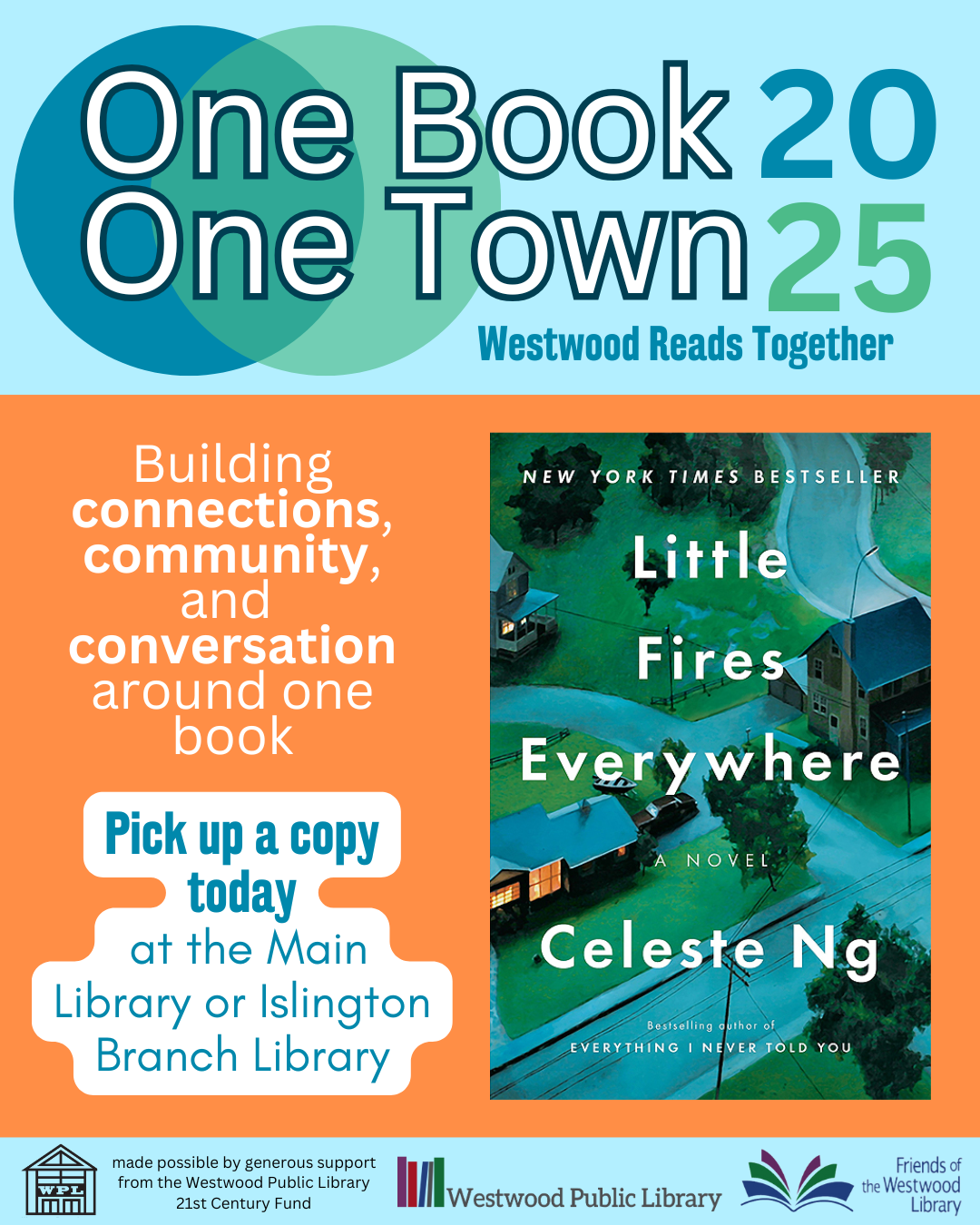
Did you read Little Fires Everywhere and simply can't wait to talk about it with someone?
Join our Community Discussions on Tuesday, March 4, 10am at the Islington Branch and Thursday, March 13, 7pm at the Main Library
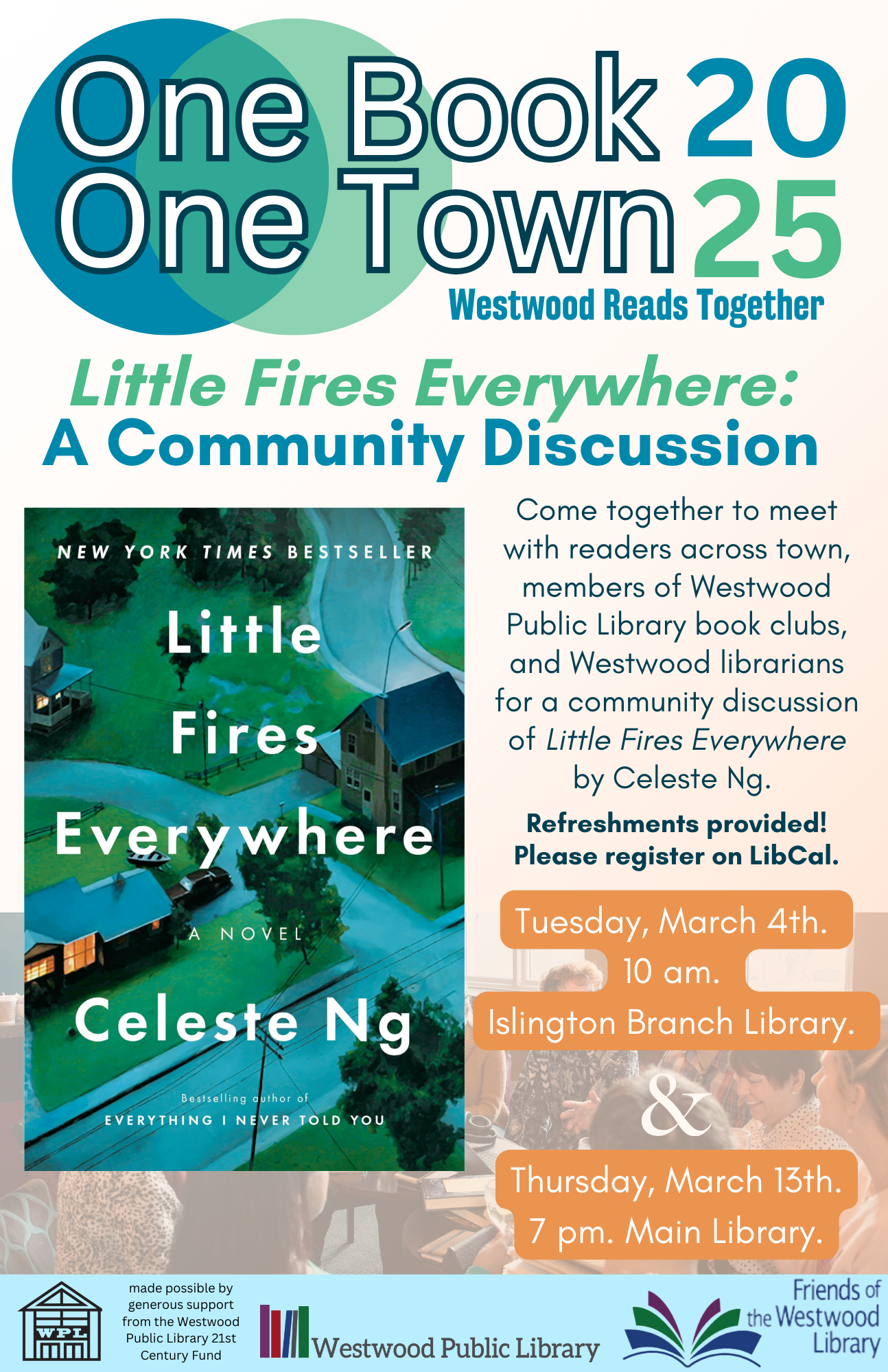
Join us for our One Book One Town: Westwood Reads Together celebration through art! Come listen to Massachusetts artist, Rebecca McGee Tuck, talk about Art to Activism. Be transformed as you listen in on how art can be transformative throughout the human experience! Rebecca is an artist and sculptor, and her work has been featured in exhibits across the Northeast including: Cape Cod Art Museum, Fitchburg Art Museum, and Boston Sculptors Gallery.
Rebecca's art is intended to be a beacon of hope, demonstrating the transformative power of art and advocating for positive change! Come be inspired during this artist talk on Monday, March 3 at 7:00 PM. Please register in advance.
Join us for a screening of and discussion about the 1997 documentary, Shaker Heights: The Struggle for Integration, chronicling a moment of reckoning with inequity in the town where Little Fires Everywhere takes place.
"Shaker Heights, a suburb of Cleveland, Ohio, is noted for its affluence, the quality of its public schools, and its success at racial integration. But an article in the local high school newspaper reporting wide racial disparity in the student test scores challenged the community's assumption of racial equality. The documentary examines the ideals and the realities of a community where black and white families have lived side by side for nearly 40 years."
Technology Help
Schedule a one-on-one tech help appointment at the Main Library or Islington Branch!
Library Newsletter
Find out about upcoming events, new titles, and all things Westwood Library.
Need WiFi on the go? Check out a Mobile Hotspot
at the Westwood Public Library!
The Library now offers Mobile Beacon 4G mobile hotspots. Internet service is provided on TMobile's 4G LTE network allowing library patrons access to high-speed internet service anywhere a cell phone signal can be received. Up to 10 devices can be connected, with unlimited data. Must be at least 18 years of age to check out a hotspot. Click here for additional information about borrowing hotspots.
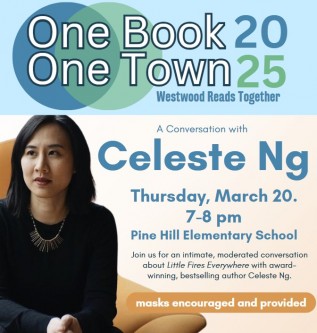
.png)
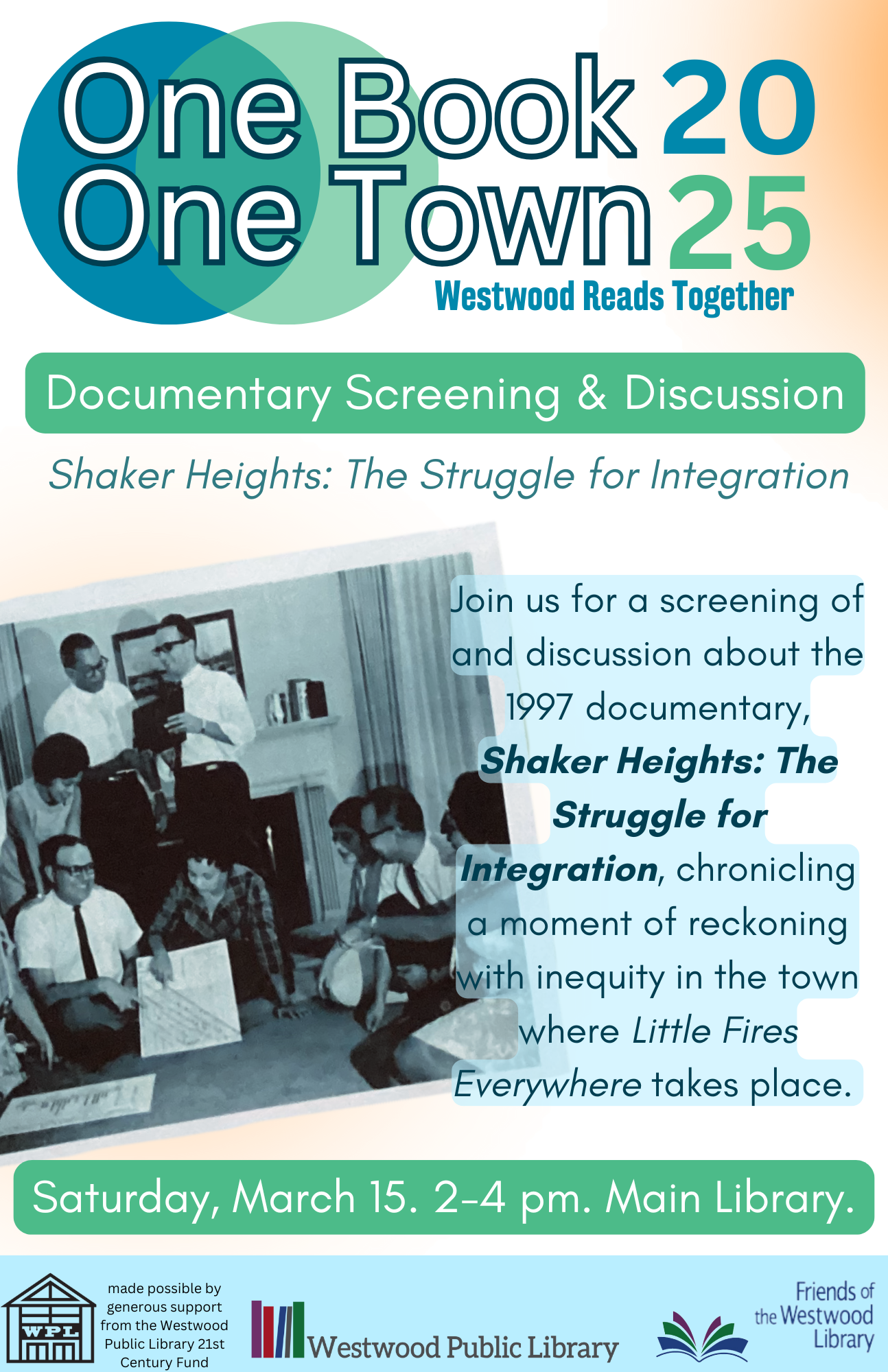
.png)


